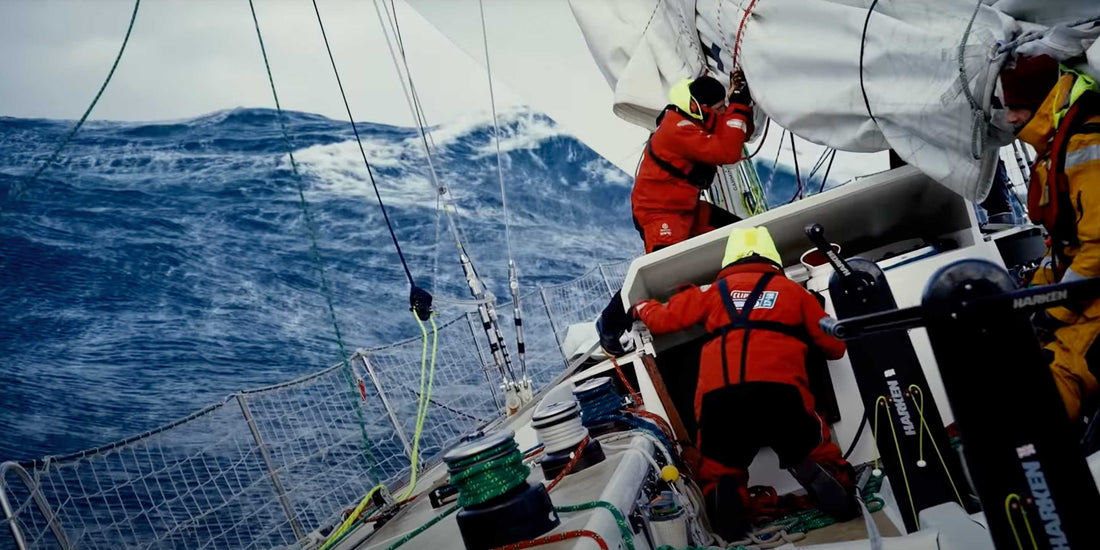The quest for speed and efficiency on water has driven the evolution of sailboat rigging from traditional ropes to advanced synthetic fibers. These modern materials offer unparalleled advantages in terms of strength, weight, and durability, making them indispensable in the high-performance sailing world. Let's delve deeper into the unique properties and applications of these core materials, highlighting their critical roles in sailing rigging.
HMPE
Dyneema, Spectra, Robtec
High Modulus Polyethylene (HMPE), recognized under the trade names Dyneema, Spectra, and Robtec, stands as a pivotal element in the realm of performance sailing. This synthetic marvel is lauded for its unmatched strength-to-weight ratio, surpassing nearly all other materials in tensile strength while offering formidable resistance to UV rays, abrasion, and moisture. Its applications are broad yet specific, catering to the needs for low stretch and high load capacity essential in the crafting of halyards, sheets, and control lines. Among its variants, Dyneema SK78 is particularly appreciated for offering an optimal balance between tensile strength and elongation, coupled with a more accessible price point, making it a popular choice for competitive yet cost-conscious sailors. On the other hand, SK99 raises the performance benchmark with its unparalleled strength and minimal stretch, securing its position as the preferred choice within the elite grand prix racing circuit, where the minutiae of rigging performance can decisively influence race outcomes. Typically found as a single braided line for direct load applications or as the core in double-braided lines for enhanced durability, HMPE also serves as a high-abrasion-resistant cover in rigging solutions demanding the utmost in wear resistance.
Liquid Crystal Polymer
Vectran
Vectran excels in applications requiring minimal elongation under load, thanks to its exceptional strength and low creep characteristics. This liquid crystal polymer is also highly resistant to UV exposure and abrasion, making it an ideal candidate for standing rigging and high-load bearing halyards on performance sailboats. Its durability and consistent performance under extreme conditions make Vectran a reliable ally for sailors navigating challenging environments.
Aramid
Kevlar, Technora
Aramid fibers, including Kevlar and Technora, are prized for their heat and chemical resistance, essential for lines facing high friction and temperatures. Technora excels with minimal stretch under load, keeping sail shapes consistent. These fibers are often used in the cores of halyards and sheets, where precision is critical. Additionally, fibers like Technora feature in line covers for their abrasion resistance, ideal for high-friction areas or cleat use, ensuring durability and performance in demanding sailing conditions.
Polyester
Dacron, Terylene
Polyester, with renowned variants like Dacron and Terylene, is a mainstay in sailing for its balanced mix of performance, durability, and affordability. It's favored for sails and lower-performance rigging, thanks to its UV resistance and consistent stretch. This makes it ideal for cruising and club racing, where reliability and ease of handling are prioritized alongside performance. Polyester's durability also makes it a popular choice for covers of performance lines, particularly in smaller control lines or sheets, where it adds an extra layer of protection without compromising functionality.
Polyamide
Nylon, Cordura
Nylon and Cordura, both polyamides, excel in shock absorption and elasticity, ideal for high-impact and stretch-reliant applications like dock lines, anchor rodes, and safety gear. Their robustness and capacity to absorb energy safeguard boats and gear against dynamic stresses. Additionally, Cordura's durability makes it a favored choice for the covers of double-braided lines, enhancing wear resistance in demanding marine environments.
Polypropylene
Marlen, Olefin
Polypropylene, identified by names like Marlen and Olefin, is chosen for its lightweight, buoyant qualities, making it suitable for floating lines. While not as strong or UV resistant as other fibers, its ability to float makes it ideal for applications where losing a line overboard could be problematic, such as throw lines and sea anchors.
Core/Cover Combinations and Product Examples
The synergy between different materials in core/cover combinations unlocks new levels of performance and durability in sailing rigging:

-
Dinghy Control (Polyester/Dyneema): This combination uses a durable polyester cover to protect an HMPE core, offering a blend of durability and strength with minimal stretch. Ideal for dinghy control lines, it ensures precise trim and adjustment, critical in competitive sailing environments.

-
Dinghy Polytech (Technora/Dyneema): Combining the abrasion resistance of Technora with the strength and low stretch of HMPE, Dinghy Polytech lines are perfect for applications requiring high durability and performance, such as sheets and control lines on high-performance dinghies.

-
Ocean All Black (Robtec): Robtec, a black HMPE fiber, matches Dyneema's performance but with a fade-resistant black color, unlike dyed Dyneema. This makes it ideal for sailors valuing durability and color stability.

- Ocean 7000 (SK99 Dyneema): Ocean 7000 is made up of SK99 Dyneema fibers and offers a lower stretch or creep when compared to SK78 or Robtec. Ideal in situation likes halyards where minimal stretch is necessary

-
Dinghy Sheet (Polyester/Polyamide): Designed for cruising yachts, this combination features a polyamide core for elasticity and shock absorption, encased in a high-durability polyester cover. It's ideal for cruising sheets and halyards, where comfort, ease of handling, and durability are key.
These advanced core/cover combinations are exemplified in products like Dinghy Control, Dinghy Polytech, and Ocean All Black, each engineered to meet the specific needs of sailors across a spectrum of applications. Whether it's for the high-strain demands of racing or the durability required for cruising, these innovative materials and combinations set new standards in sailing performance.

